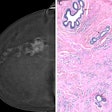While Heinlein's and Monsees’ talks focused on mammography, other researchers are touting MRI as the best modality for imaging implants.
In a study published in the American Journal of Roentgenology, a population of women in Birmingham, AL, underwent MR imaging of their silicone breast implants at the University of Alabama. The majority of the women -- 85% -- had mammoplasty for cosmetic reasons; the remainder for medical issues, such as fibrocystic breasts.
The study was administered by researchers from the FDA's Center for Devices and Radiological Health and the radiology departments at University of Maryland in Baltimore, Duke University in Durham, NC, and the University of California, San Diego.
The group said they chose to use MR because "mammography is the least sensitive imaging method for examining breast implant rupture with a sensitivity of 11% to 59%. MR imaging has been reported to have a sensitivity from 52% to 95% when [radiologists] used a breast coil" (AJR, October 2000, Vol.175: 4, pp.1057-1064).
In their study population, 344 women were imaged on a 1.5-tesla scanner (Signa Horizon from GE Medical Systems, Waukesha, WI) using a dedicated GE bilateral phased-array breast surface coil.
"The goals were to determine whether implants were ruptured and whether any extracapsular silicone was present," they wrote.
After a T2-weighted scout sequence, four additional sequences were performed on each breast independently:
- An axial T2-weighted fast spin-echo inversion recovery sequence with water suppression.
- An axial T2-weighted fast spin-echo sequence with silicone suppression.
- A sagittal T2-weighted fast spin-echo sequence with water suppression including the portion of the implant showing folds.
- An axial fast spin-echo T2-weighted sequence with water suppression in order to look at the folds outside the implant for signs of gel leakage.
Three radiologists reviewed the scans. They agreed that 55% of the 687 implants were ruptured, while the status of another 7.2% was undetermined. Out of 344 women, 68% had at least one ruptured implant, they reported.
"Migration of silicone beyond the fibrous capsule was observed in 85 breasts," the investigators said. "The prevalence of extracapsular silicone for ruptured implants was 84 or 378 ruptured implants. Silicone had migrated beyond the capsule in at least one breast in 21% of the women in this study."
Finally, the group determined that "rupture prevalence increased as implant age increased from 6 to 20 years, a conservative estimate of median age of implant rupture was 10.8 years. We believe it is time to reevaluate the need to screen women for implant rupture and to develop recommendations for implant removal or replacement in the event of rupture."
One of the radiologic signs of rupture is the linguine sign, described in detail by Dr. Amjad Savfi from Northwestern Memorial Hospital in Chicago. The linguine sign is caused when the one component of the implant, the elastomeric shell, breaks and releases silicone. As the shell collapses, the serpentine line represents the layers floating inside, he said (Radiology, September 2000, Vol.216:3, pp.838-839).
Finally, radiologists from Case Western Reserve University in Cleveland compiled a breast implant classification system for correlation with MRI. Reviewing over 4,000 cases, Dr. Michael Middleton and Dr. Michael McNamara, Jr. offer a history of breast augmentation, as well as the risk factors for implant failure (RadioGraphics, May 2000, Vol.20:3, available online).
By Shalmali Pal
AuntMinnie.com staff writer
November 10, 2000
Let AuntMinnie.com know what you think about this story.
Copyright © 2000 AuntMinnie.com



















